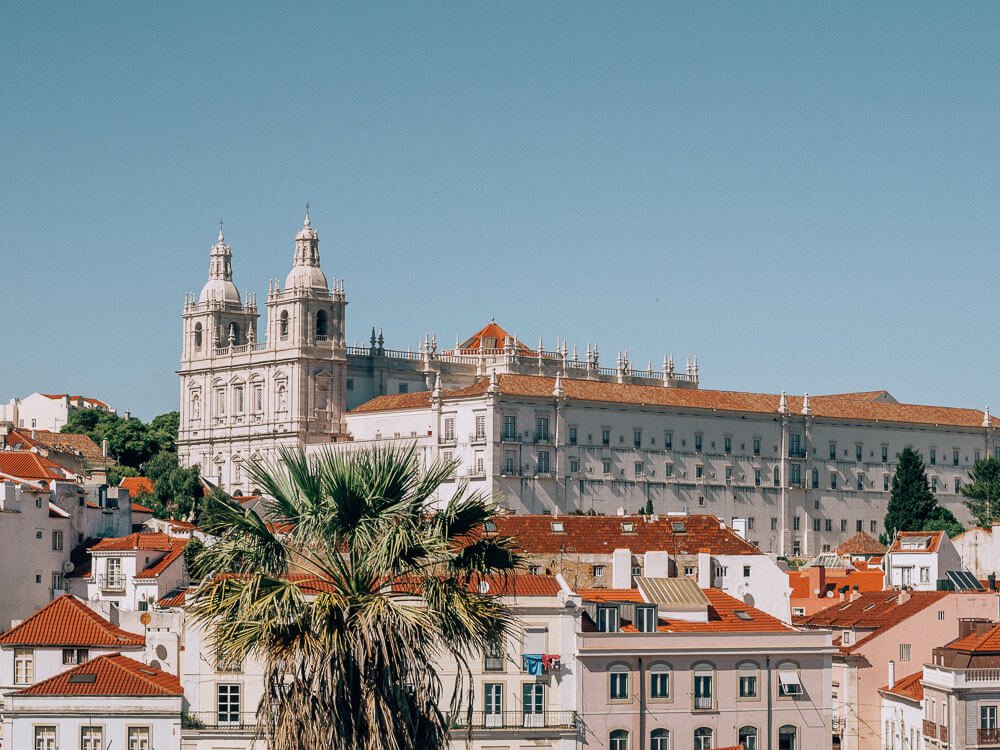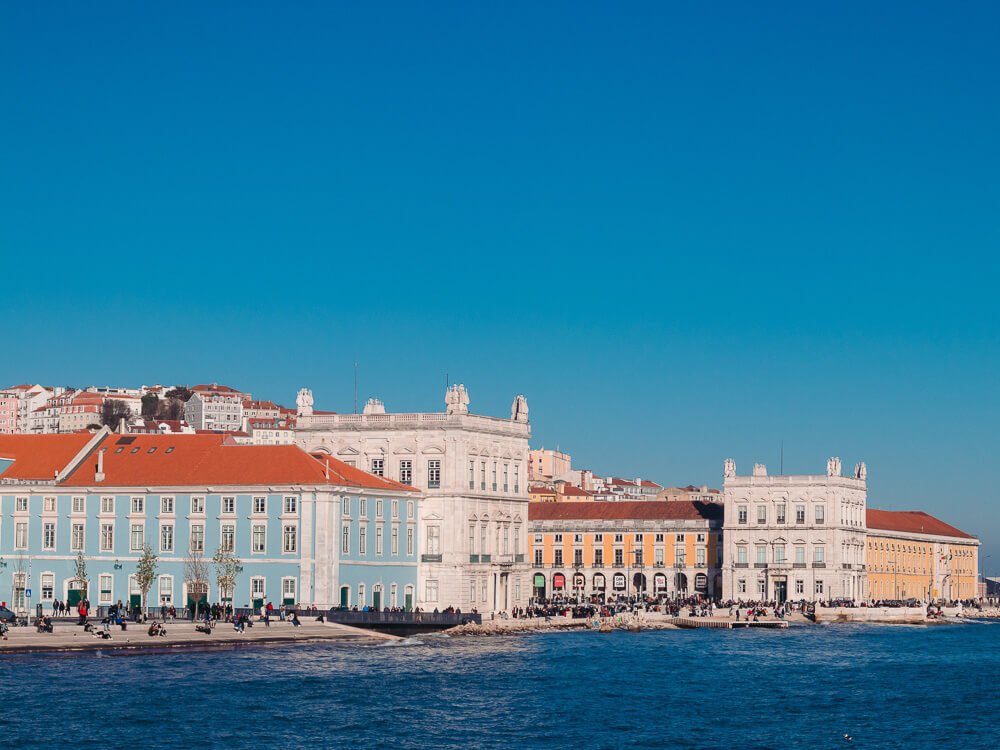Wondering if you should visit Lisbon? Here are 12 reasons why the answer is yes!
There’s no shortage of reasons for travelers to place Lisbon at the top of their must-visit list. To start with, the culinary scene is simply delightful. But there’s so much more than just amazing seafood and pastéis de nata.
Lisbon is a city where history meets modernity, bringing a unique charm to it. Not only are there fascinating landmarks, historical neighborhoods, and lots of azulejos that narrate tales from Portugal’s past, but also a lively nightlife that will impress even the most discerning partygoer.
Today, I’ll tell you 12 reasons to visit Lisbon. So, join me and discover why this should be your next destination!
Index
- Why visit Lisbon?
- Challenges of visiting Lisbon
- Why choose Lisbon over Madrid?
- Why choose Lisbon over Porto?
- How many days should you stay in Lisbon?
1. Why visit Lisbon?

climate
One of the main advantages of visiting Lisbon is that you’ll find great climatic conditions throughout the entire year, ideal for outdoor activities and sightseeing. After all, this is one of the sunniest capitals in all of Europe!
The summers in Lisbon are hot and dry, while the winters are chilly (but still mild compared to other European destinations) and rainy, although it’s still possible to enjoy clear skies even in December.
Spring and fall are also very pleasant seasons, when the weather is neither too hot nor cold. And, truth be told, these are my favorite times of year to visit Lisbon! But no matter when you decide to go, you won’t be disappointed.
Architecture
Lisbon’s architecture is an attraction on its own. The city is renowned for its diversity of styles that stretch across centuries, reflecting the periods that have shaped its history.
The downtown area, in Baixa, is characterized by Pombaline architecture, named after Marquis of Pombal, who spearheaded the city’s reconstruction after the 1755 earthquake. The buildings’ uniform and harmonious façades are combined with remarkable earthquake-resistant engineering prowess.
Meanwhile, the Manueline style found in Jerónimos Monastery and National Tile Museum showcase intricate ornamentation with maritime motifs, reflecting Portugal’s seafaring legacy.
And let’s not forget about the Gothic buildings, such as Carmo Convent and Lisbon Cathedral, and the Baroque influences at Igreja de São Roque and the National Pantheon.
Besides all the amazing architectural styles, much of Lisbon’s charm lies in the azulejo-covered buildings. These traditional white-and-blue ceramic tiles often have intricate patterns or depict historical scenes. They are truly mesmerizing, and a great reason to visit the city!
Local cuisine
Another thing Portugal is renowned for is its culinary scene. And, if you’re a fan of seafood, you’re in for a treat! The most traditional dish is the salted cod (or bacalhau), which is served in a great variety of ways. Some of them are:
- Bacalhau à Brás: a mix of shredded cod, thinly sliced potatoes and onions bound together with scrambled eggs.
- Bacalhau com natas: baked cod with cream
- Bacalhau à Gomes de Sá: a casserole of cod, potatoes, egg, olive oil, olives and onion.
- Bolinhos de bacalhau: cod fritters
But don’t be fooled into thinking bacalhau has all the limelight!
Sardines are also a highlight of Portuguese cuisine. Either grilled over charcoal (especially during the Popular Saints festivals in the Summer) or in numerous traditional dishes, you simply must try them.
Then comes the crowning glory of Portugal’s sweet treats: pastéis de nata. It’s hard to put into words just how delicious these crispy and creamy custard tarts are! Seriously. They just might be my favorite thing in the world.
The original recipe (which is still a secret!) was created by the monks of Jerónimos Monastery in the 18th century, and you can taste them at Pastéis de Belém. This is the only place where they can be called pastéis de Belém, the rest are simply pastéis de nata. Either way, they are incredible!
And, of course, no trip to Portugal would be complete without some renowned wines, from robust reds of Douro Valley to the aromatic vinho verde. You’ll also need to try the traditional ginja, an irresistible cherry liqueur very popular among locals and tourists.
Affordability
Good news for the budget traveler! Lisbon is one of the most affordable capitals in Europe for a number of reasons.
The city’s compact size means it’s very walkable, so you won’t need to spend a lot with transport. And, when it comes to food, you can find mouth-watering dishes at reasonable prices at local markets and non-touristy restaurants.
Besides that, many of Lisbon’s attractions and famous landmarks are free, such as the miradouros, squares like Praça do Comércio and Praça do Rossio, Monumento to the Discoveries, Parque Eduardo VII and Igreja de São Roque.
There are even the ruins of a roman theater you can visit for free! And the attractions that do have a fee are not very expensive at all.
safety
Portugal is ranked as one of the world’s safest countries, and Lisbon is a great example of that. Even though it’s a big city, the crime rates are very low!
Of course, that doesn’t mean it’s completely crime free. As many popular tourist destinations, Lisbon has a pickpocketing problem. Just remember to keep a close eye on your belongings, especially in crowded areas and public transportation, and you’ll be fine!
Also, Lisbon is an LGBTQ+ friendly city, and there’s even a neighborhood full of bars aimed towards the community (more on that later!).
Nightlife
Lisbon is one of those cities that really comes alive late in the evening, and it’s not unusual for people to stay up all night to see the sunrise at one of the many miradouros.
The Portuguese are known for having late dinners, so don’t be surprised if the bars and clubs are still empty at 9pm. People usually start arriving at around 11pm and keep partying until 4am.
If you’re planning on exploring Lisbon’s nightlife, I only have one important piece of advice: forget about wearing high heels! You’ll thank me when you see the cobblestone streets and steep hills.
When it comes to selecting a place for your night out in Lisbon, there are a lot of options. Pink Street and Bairro Alto, for example, offer an array of bars with free entry, giving you more freedom to explore different places.
If you’d like a more traditional evening, you can head to Alfama for some Fado music and dinner. Or, if you’re looking for those LGBTQ+ bars I mentioned earlier, Príncipe Real is the neighborhood you should go to.
Breathtaking views
According to legend, Lisbon was built on seven hills. It’s actually eight, but that’s neither here nor there! The point is that it’s a very hilly city, which means there are spectacular views waiting for you there.
That’s why the miradouros, or viewpoints, are one of the main attractions of Lisbon. They offer an unparalleled view of the city’s red rooftops, narrow alleys, broad squares and multi-colored buildings cascading towards the Tagus River.
And there are a lot of them! For example, the Miradouro da Senhora do Monte is the highest viewpoint in the city, while Miradouro da Graça offers sweeping views as far as Castelo de São Jorge (which is also one of the best places to view the city!). There’s also Miradouro das Portas do Sol and Miradouro de Santa Luzia, which are right next to each other and offer great views over Alfama.
Historical significance
For those who love exploring historical places, Lisbon is one of the greatest destinations. After all, this is the most ancient city in Europe after Rome.
There, you’ll find remains of the Roman and Moorish occupation in Portugal, such as the ruins of a Roman Amphitheatre and the entire neighborhood of Alfama, which is believed to have been built by the Moors in the 8th century.
In fact, Alfama is the only neighborhood that survived almost intact to the devastating 1755 earthquake, which reduced Lisbon to ruins. The city was pretty much rebuilt from scratch after that, and the disaster shaped a lot of its history.
And, of course, we can’t forget that Lisbon had an essential role as a pioneer during the Age of Discoveries, immortalized in landmarks such as the Torre de Belém and Padrão dos Descobrimentos.
The fact that Lisbon has such a long and fascinating history only adds to its charm, and exploring all its historical sites is something everyone should do at least once in their life!
Unique culture and lifestyle
When I visited Lisbon for the first time, I was expecting to find a capital like all the others I’d visited before. But, boy, was I wrong!
Even though this is a big city, it doesn’t really feel like it. The whole place has a relaxed and laid-back vibe that invites you to calmy stroll its ancient streets, have leisurely lunches, and stop at cafés in the middle of the afternoon to unwind.
You’ll also notice that the Portuguese tend to be very warm and welcoming towards foreigners, making you feel right at home. It’s no wonder so many people choose to move to Lisbon after visiting it!
This unique blend of slow living, welcoming vibe and friendly people make visiting Lisbon an unforgettable cultural experience unlike any other.
Festivals and events
Lisbon is one of those places where there’s always something interesting happening. Not only does the city have a lively nightlife, but it’s also known for having tons of traditional events and music festivals. You won’t have a moment of boredom there!
Here are some of the main events:
- Carnaval, which transforms Lisbon into a spectacle with costumed parades and lively street performances.
- Popular Saints celebrations, with several street parties (known as arraias) being held all over the city.
- Jazz em Agosto, which brings great names of contemporary jazz to the Open Air Amphitheatre of the Gulbenkian Foundation.
- Super Bock Super Rock, a music festival that has taken place annually since 1995.
- NOS Alive, a 3-4 day music and arts festival that has taken place annually since 2007.
- Rock in Rio Lisboa, one of the most important music festivals, with several activities and entertainment.
- IndieLisboa, an independent film festival.
- DocLisboa, a documentary film festival.
- Monstra Festival, an animated film festival.
And these are just a few of the city’s events! Trust me, it’s almost impossible not to find something that fits your interests there.
Location
Alright, now let’s talk about Lisbon’s location: it’s one of the best I’ve ever seen! It’s roughly in the middle of the country, while still being close to the coast, which means it’s very easy to reach every corner of Portugal.
There are amazing beaches nearby, and both the northern and southern regions are just a train or bus ride away. In fact, Lisbon is very well connected to the entire country by public transport, which makes things so much easier.
By making Lisbon your base camp, you can get to know the country with minimal headaches and really immerse yourself in Portuguese culture.
Day trips
Another highlight of Lisbon is the great variety of day trip options. Seriously, there are so many places nearby that you’ll wish you could dedicate a whole month just for exploring them!
Sintra is a must-visit town just 40-minutes away from Lisbon. This is where you’ll find Pena Palace, a colorful castle that looks straight out of a fairytale, the Moorish Castle and Quinta da Regaleira.
And if you’re still craving some more historical destinations, you can’t go wrong with Óbidos, a charming medieval village; Coimbra, home to the oldest university of Portugal; and Évora, known for its ancient roman ruins and the eerie Bones Chapel.
There are also plenty of coastal towns if you want to spend some time at the beach, such as Cascais, one of the most famous resort towns, with amazing golden sand beaches; and Nazaré, which is world-famous for its giant waves.
And these are just a few options! It’s definitely worth doing some research to find the one that really speaks to your heart (I’m sure you’ll come across several!)
2. Challenges of visiting lisbon

After 12 reasons to visit Lisbon, I believe I may have convinced you to plan your trip to the Portuguese capital, right? But before you start packing your bags in a rush, there are two points that deserve your attention:
Topography
Lisbon is known for its hills and cobblestone streets, but, while they make for some amazing views, I can’t deny walking through them can be quite challenging at times. After all, the hills are very steep, and the streets are uneven and can become very slippery when it rains.
But that shouldn’t stop you from visiting the city! Thankfully, Lisbon’s iconic yellow trams are an excellent solution to help you navigate even the steepest hills. They’re not just a charming attraction, they’re actually used as a means of transportations for both locals and tourists.
As for the cobblestone streets, they’re not impossible to get used to as long as you bring comfortable walking shoes!
Overcrowding and cost fluctuations
In the last couple of years, Lisbon has become a top vacation destination, with millions of tourists from across the globe flocking to the city every year.
While it’s great that Lisbon is finally getting the recognition it deserves, it also means things are a lot different now than they were 10 years ago, particularly when it comes to overcrowding and cost fluctuations.
During summer months, for example, you can expect massive tourist crowds in Lisbon. This means lots of queues in all attractions, sold out events and completely booked hotels.
Besides that, the prices tend to rise considerably during the high season. Yes, I know I said Lisbon was affordable… And it still is, especially if we compare it to other capitals.
However, prices have been skyrocketing during the high season these last few years. Because of the high demand, accommodations are way more expensive and more difficult to find, and many touristy restaurants also raise their prices.
But don’t let that discourage you from visiting Lisbon! One solution is to find accommodations farther away from the city center and look for more traditional restaurants instead of the usual tourist places.
Also, if possible, try to visit during the shoulder or low season, when most of the crowds have left the country and prices are lower.
3. why visit lisbon over madrid?

Madrid and Lisbon are the two largest cities on the Iberian Peninsula, both featuring lively nightlives and rich cultural experiences. Yet, when choosing between these two destinations, you might want to lean towards Lisbon.
Why? Well, for starters, you’ll find more things to do and visit in Lisbon than in Madrid. Portugal’s capital has a wider variety of activities for all tastes, whether you prefer to visit historical sites, museums, go on food tours, day trips or music festivals.
Another thing that sets Lisbon apart is its proximity to beaches. Unlike Madrid, Portugal’s beautiful coastline is just a short trip away. On top of that, the weather in Lisbon is also better, with sunnier and warmer days perfect to enjoy a day at the beach.
Lisbon also tends to be less expensive than Madrid, so if budgeting is one of your main concerns when planning trips, remember to take that into consideration.
4. why visit lisbon over porto?

As the two largest cities in Portugal, you’ll find amazing attractions in both cities, as well as friendly locals and fantastic cuisine. Both are worth visiting, but, in my opinion, Lisbon should be your priority, especially when going to Portugal for the first time.
That’s because Lisbon has more attractions than Porto and is where you’ll find all the most iconic and important monuments of the country, such as Belém Tower and Jerónimos Monastery.
Lisbon also has more accommodation options than Porto, as well as a more comprehensive public transport system, which features buses, trams (including the famous Tram 28), metro lines and even ferries that efficiently connect the city and surroundings.
Lastly, the weather in Lisbon is a lot more pleasant than in Porto, which is known for being a rainy destination. In Lisbon, you’ll be able to enjoy drier conditions and warmer temperatures, ideal for sightseeing and day trips.
5. how many days should you stay in lisbon?
When it comes to Lisbon, my recommendation would be giving yourself at least 3 days. This should be enough time to explore the city’s attractions without having to rush through.That said, if pressed for time, it’s possible to visit the major highlights of Lisbon in 3 days with a well-planned itinerary. Just prepare for a faster-paced trip!
final verdict: is lisbon worth visiting?

Yes, absolutely! Lisbon is a beautiful and charming city, with a unique vibe and many tourist attractions to keep you entertained for a very long time. I’m sure you’re going to fall in love with this city just like I (and everyone I know) did!







